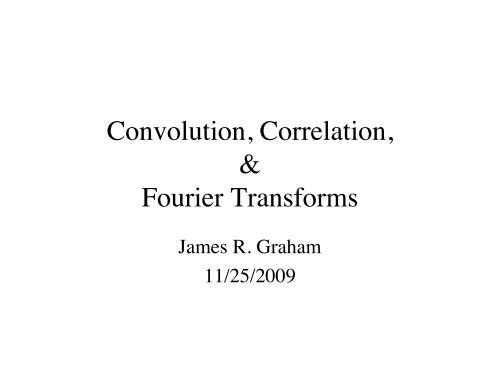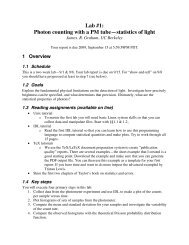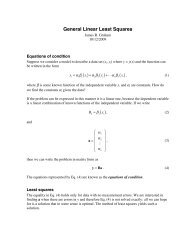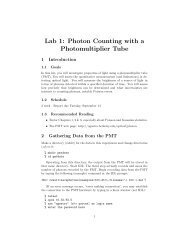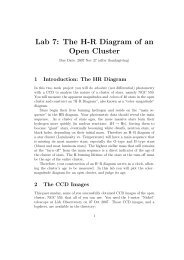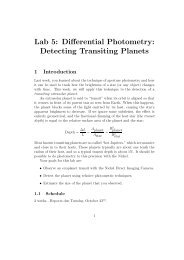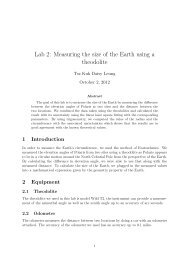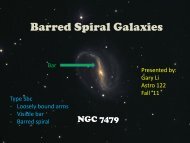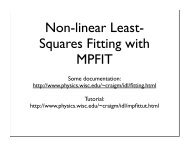Fourier transforms & the convolution theorem - UGAstro
Fourier transforms & the convolution theorem - UGAstro
Fourier transforms & the convolution theorem - UGAstro
You also want an ePaper? Increase the reach of your titles
YUMPU automatically turns print PDFs into web optimized ePapers that Google loves.
Convolution, Correlation,<br />
&<br />
<strong>Fourier</strong> Transforms<br />
James R. Graham<br />
11/25/2009
Introduction<br />
• A large class of signal processing<br />
techniques fall under <strong>the</strong> category of<br />
<strong>Fourier</strong> transform methods<br />
– These methods fall into two broad categories<br />
• Efficient method for accomplishing common data<br />
manipulations<br />
• Problems related to <strong>the</strong> <strong>Fourier</strong> transform or <strong>the</strong><br />
power spectrum
Time & Frequency Domains<br />
• A physical process can be described in two ways<br />
– In <strong>the</strong> time domain, by h as a function of time t, that is<br />
h(t), -∞ < t < ∞<br />
– In <strong>the</strong> frequency domain, by H that gives its amplitude<br />
and phase as a function of frequency f, that is H(f), with<br />
-∞ < f < ∞<br />
• In general h and H are complex numbers<br />
• It is useful to think of h(t) and H(f) as two<br />
different representations of <strong>the</strong> same function<br />
– One goes back and forth between <strong>the</strong>se two<br />
representations by <strong>Fourier</strong> <strong>transforms</strong>
<strong>Fourier</strong> Transforms<br />
∞<br />
∫<br />
−∞<br />
H( f )= h(t)e −2πift dt<br />
h(t)=<br />
∞<br />
∫<br />
−∞<br />
H ( f )e 2πift df<br />
• If t is measured in seconds, <strong>the</strong>n f is in cycles per<br />
second or Hz<br />
• O<strong>the</strong>r units<br />
– E.g, if h=h(x) and x is in meters, <strong>the</strong>n H is a function of<br />
spatial frequency measured in cycles per meter
<strong>Fourier</strong> Transforms<br />
• The <strong>Fourier</strong> transform is a linear operator<br />
– The transform of <strong>the</strong> sum of two functions is<br />
<strong>the</strong> sum of <strong>the</strong> <strong>transforms</strong><br />
h 12<br />
= h 1<br />
+ h 2<br />
H 12<br />
( f )=<br />
∞<br />
∫<br />
−∞<br />
∞<br />
h 12<br />
e −2πift dt<br />
= ∫ ( h 1<br />
+ h 2 )e −2πift dt = ∫ h 1<br />
e −2πift dt + h 2<br />
e −2πift dt<br />
−∞<br />
= H 1<br />
+ H 2<br />
∞<br />
−∞<br />
∞<br />
∫<br />
−∞
<strong>Fourier</strong> Transforms<br />
• h(t) may have some special properties<br />
– Real, imaginary<br />
– Even: h(t) = h(-t)<br />
– Odd: h(t) = -h(-t)<br />
• In <strong>the</strong> frequency domain <strong>the</strong>se symmetries<br />
lead to relations between H(f) and H(-f)
FT Symmetries<br />
If…<br />
h(t) real<br />
h(t) imaginary<br />
h(t) even<br />
h(t) odd<br />
h(t) real & even<br />
h(t) real & odd<br />
h(t) imaginary & even<br />
h(t) imaginary & odd<br />
Then…<br />
H(-f) = [ H(f) ] *<br />
H(-f) = -[ H(f) ] *<br />
H(-f) = H(f) (even)<br />
H(-f) = - H(f) (odd)<br />
H(f) real & even<br />
H(f) imaginary & odd<br />
H(f) imaginary & even<br />
H(f) real & odd
Elementary Properties of FT<br />
h(t)↔ H ( f )<br />
h(at)↔ 1 a H ( f /a)<br />
h(t − t 0<br />
)↔ H ( f )e −2πift 0<br />
<strong>Fourier</strong> Pair<br />
Time scaling<br />
Time shifting
Convolution<br />
• With two functions h(t) and g(t), and <strong>the</strong>ir<br />
corresponding <strong>Fourier</strong> <strong>transforms</strong> H(f) and<br />
G(f), we can form two special combinations<br />
– The <strong>convolution</strong>, denoted f = g * h, defined by<br />
( ) = g ∗ h ≡ g(τ )h(t −<br />
f t<br />
∞<br />
∫<br />
−∞<br />
τ )dτ
Convolution<br />
• g*h is a function of time, and<br />
g*h = h*g<br />
– The <strong>convolution</strong> is one member of a transform pair<br />
g∗ h ↔ G( f )H( f )<br />
• The <strong>Fourier</strong> transform of <strong>the</strong> <strong>convolution</strong> is <strong>the</strong><br />
product of <strong>the</strong> two <strong>Fourier</strong> <strong>transforms</strong>!<br />
– This is <strong>the</strong> Convolution Theorem
Correlation<br />
• The correlation of g and h<br />
Corr(g,h) ≡<br />
∞<br />
∫<br />
−∞<br />
g(τ + t)h(τ )dτ<br />
• The correlation is a function of t, which is<br />
known as <strong>the</strong> lag<br />
– The correlation lies in <strong>the</strong> time domain
Correlation<br />
• The correlation is one member of <strong>the</strong> transform<br />
pair<br />
Corr(g,h) ↔ G( f )H * ( f )<br />
– More generally, <strong>the</strong> RHS of <strong>the</strong> pair is G(f)H(-f)<br />
– Usually g & h are real, so H(-f) = H*(f)<br />
• Multiplying <strong>the</strong> FT of one function by <strong>the</strong><br />
complex conjugate of <strong>the</strong> FT of <strong>the</strong> o<strong>the</strong>r gives <strong>the</strong><br />
FT of <strong>the</strong>ir correlation<br />
– This is <strong>the</strong> Correlation Theorem
Autocorrelation<br />
• The correlation of a function with itself is<br />
called its autocorrelation.<br />
– In this case <strong>the</strong> correlation <strong>the</strong>orem becomes<br />
<strong>the</strong> transform pair<br />
Corr(g,g) ↔ G( f )G * ( f ) = G( f ) 2<br />
– This is <strong>the</strong> Wiener-Khinchin Theorem
Convolution<br />
• Ma<strong>the</strong>matically <strong>the</strong> <strong>convolution</strong> of r(t) and<br />
s(t), denoted r*s=s*r<br />
• In most applications r and s have quite<br />
different meanings<br />
– s(t) is typically a signal or data stream, which<br />
goes on indefinitely in time<br />
– r(t) is a response function, typically a peaked<br />
and that falls to zero in both directions from its<br />
maximum
The Response Function<br />
• The effect of <strong>convolution</strong> is to smear <strong>the</strong><br />
signal s(t) in time according to <strong>the</strong> recipe<br />
provided by <strong>the</strong> response function r(t)<br />
• A spike or delta-function of unit area in s<br />
which occurs at some time t 0 is<br />
– Smeared into <strong>the</strong> shape of <strong>the</strong> response function<br />
– Translated from time 0 to time t 0 as r(t - t 0 )
Convolution<br />
s(t)<br />
r(t)<br />
s*r<br />
• The signal s(t) is convolved with a response function r(t)<br />
– Since <strong>the</strong> response function is broader than some features in <strong>the</strong><br />
original signal, <strong>the</strong>se are smoo<strong>the</strong>d out in <strong>the</strong> <strong>convolution</strong>
<strong>Fourier</strong> Transforms & FFT<br />
• <strong>Fourier</strong> methods have revolutionized many fields<br />
of science & engineering<br />
– Radio astronomy, medical imaging, & seismology<br />
• The wide application of <strong>Fourier</strong> methods is due to<br />
<strong>the</strong> existence of <strong>the</strong> fast <strong>Fourier</strong> transform (FFT)<br />
• The FFT permits rapid computation of <strong>the</strong> discrete<br />
<strong>Fourier</strong> transform<br />
• Among <strong>the</strong> most direct applications of <strong>the</strong> FFT are<br />
to <strong>the</strong> <strong>convolution</strong>, correlation & autocorrelation<br />
of data
The FFT & Convolution<br />
• The <strong>convolution</strong> of two functions is defined for<br />
<strong>the</strong> continuous case<br />
– The <strong>convolution</strong> <strong>the</strong>orem says that <strong>the</strong> <strong>Fourier</strong><br />
transform of <strong>the</strong> <strong>convolution</strong> of two functions is equal<br />
to <strong>the</strong> product of <strong>the</strong>ir individual <strong>Fourier</strong> <strong>transforms</strong><br />
g∗ h ↔ G( f )H( f )<br />
• We want to deal with <strong>the</strong> discrete case<br />
– How does this work in <strong>the</strong> context of <strong>convolution</strong>?
Discrete Convolution<br />
• In <strong>the</strong> discrete case s(t) is represented by its<br />
sampled values at equal time intervals s j<br />
• The response function is also a discrete set r k<br />
– r 0 tells what multiple of <strong>the</strong> input signal in channel j is<br />
copied into <strong>the</strong> output channel j<br />
– r 1 tells what multiple of input signal j is copied into <strong>the</strong><br />
output channel j+1<br />
– r -1 tells <strong>the</strong> multiple of input signal j is copied into <strong>the</strong><br />
output channel j-1<br />
– Repeat for all values of k
Discrete Convolution<br />
• Symbolically <strong>the</strong> discrete <strong>convolution</strong> is<br />
with a response function of finite duration,<br />
N, is<br />
N / 2<br />
∑<br />
k=−N / 2 +1<br />
( s∗ r) = s r j k j−k<br />
( s∗ r) ↔S R j l l
Discrete Convolution<br />
s j<br />
r k<br />
(s*r) j<br />
• Convolution of discretely sampled functions<br />
– Note <strong>the</strong> response function for negative times wraps<br />
around and is stored at <strong>the</strong> end of <strong>the</strong> array r k
Examples<br />
• Java applet demonstrations<br />
– Continuous <strong>convolution</strong><br />
• http://www.jhu.edu/~signals/convolve/<br />
– Discrete <strong>convolution</strong><br />
• http://www.jhu.edu/~signals/discreteconv/
Suppose that f and g are functions of time<br />
f (t) =<br />
∞<br />
∫ F(ν) e 2πiνt dν and g(t)= ∫ G(ν) e 2πiνt dν<br />
-∞<br />
The <strong>convolution</strong> f*g says<br />
f ∗ g =<br />
∫<br />
∞<br />
-∞<br />
g(t ') f (t − t ') dt '<br />
∞<br />
∞<br />
= ∫<br />
2πiν (t −t ')<br />
g(t ') ⎡ ∫ F(ν) e dν ⎤dt '<br />
-∞ ⎣⎢ -∞<br />
⎦⎥<br />
Swap <strong>the</strong> order of integration<br />
∞<br />
∞<br />
= ∫ F(ν) ⎡<br />
∫ g(t ') e −2πiνt ' dt ' ⎤e -∞ ⎣⎢ -∞<br />
⎦⎥<br />
2πiνt dν<br />
= FT F(ν)G(ν)<br />
Voila!<br />
[ ]<br />
∞<br />
-∞


